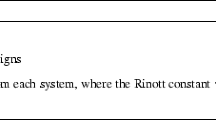Abstract
In this article, we address the profit maximization version of the dynamic economical problem where we charge a cost per price change. This model makes an explicit link between the number of price changes and the cost of changing prices. Hence, this new cost can determine the number of different possible prices, especially when all others costs are constant, as well as it reflects the real cost of changing prices (labor, communication and so on). To solve our model, we describe a simple  heuristic that strongly outperforms state-of-art solvers even for medium-size instances. Furthermore, we give numerical evidence that charging a cost per price change does not impact setups in general, even if it deeply modifies the pricing.
heuristic that strongly outperforms state-of-art solvers even for medium-size instances. Furthermore, we give numerical evidence that charging a cost per price change does not impact setups in general, even if it deeply modifies the pricing.










Similar content being viewed by others
Notes
α t =100, β t =4, s t =50, v t =20, h t =1, ∀t.
Or when parameters are substituted by their average.
Values are rounded to stay integer.
Data contain eight different values of holding cost, producing cost and demand intercept. They also include 5 different costs of price change, 11 different demand slopes, 10 setup cost values.
T=20.
The negative sign means that our heuristic returns a objective at most 0.004 per cent superior to Gurobi.
The authors do not provide any numerical examples, but each pricing iteration leads to solve a so-called Wagner and Whitin problem.
The same results are obtained for all value of θ.
More cases are improved.
The profit is bigger.
Data are the same as in Figure 1.
References
Ahn, H.-S., Gümüs, M. and Kaminsky, P. (2007) Pricing and manufacturing decisions when demand is a function of prices in multiple periods. Operations Research 55 (6): 1039–1057.
Bergen, M., Ritson, M., Dutta, S., Levy, D. and Zbaracki, M. (2003) Shattering the myth of costless price changes. European Management Journal 21 (6): 663–669.
Biller, S., Chan, L., Simchi-Levi, D. and Swann, J. (2005) Dynamic pricing and the direct-to-customer model in the automotive industry. Electronic Commerce Research 5 (2): 309–334.
Bolton, R., Shankar, V. and Montoya, D. (2010) Recent trends and emerging practices in retailer pricing. Retailing in the 21st Century: 301–318, http://dx.doi.org/10.1007/978-3-540-72003-4_19.
Chan, L., Shen, Z., Simchi-Levi, D. and Swann, J. (2004) Coordination of pricing and inventory decisions: A survey and classification. International Series in Operations Research and Management Science: 335–392, doi:10.1007/978-1-4020-7953-5_9.
Deng, S. and Yano, C. (2006) Joint production and pricing decisions with setup costs and capacity constraints. Management Science 52 (5): 741–756.
Elmaghraby, W. and Keskinocak, P. (2003) Dynamic pricing in the presence of inventory considerations: Research overview, current practices, and future directions. Management Science 49 (10): 1287–1309.
Feng, Y. and Gallego, G. (1995) Optimal starting times for end-of-season sales and optimal stopping times for promotional fares. Management Science 41 (8): 1371–1391.
Feng, Y. and Xiao, B. (2000) Optimal policies of yield management with multiple predetermined prices. Operations Research 48 (2): 332–343.
Fukukawa, K., Ennew, C. and Diacon, S. (2007) An eye for an eye: Investigating the impact of consumer perception of corporate unfairness on aberrant consumer behavior. Research in Ethical Issues in Organizations 7: 187–221.
Gilbert, S. (1999) Coordination of pricing and multi-period production for constant priced goods. European Journal Of Operational Research 114 (2): 330–337.
Hanks, R.D., Cross, R.G. and Noland, R.P. (1992) Discounting in the hotel industry: A new approach. The Cornell Hotel and Restaurant Administration Quarterly 33 (1): 15–23.
Haugen, K., Lanquepin-Chesnais, G. and Olstad, A. (2012) A fast lagrangian heuristic for large-scale capacitated lot-size problems with restricted cost structures. Kybernetika 48 (2): 329–345.
Kimes, S. (1994) Perceived fairness of yield management. The Cornell Hotel and Restaurant Administration Quarterly 35 (1): 22–29.
Kunreuther, H. and Schrage, L. (1973) Joint pricing and inventory decisions for constant priced items. Management Science 19 (7): 732–738.
Levy, D., Bergen, M., Dutta, S. and Venable, R. (1997) The magnitude of menu costs: Direct evidence from large us supermarket chains. The Quarterly Journal of Economics 112 (3): 791–824.
Link, H. (2004) Pep – A yield-management scheme for rail passenger fares in Germany. Japan Railway & Transport Review 38: 50–55.
Manne, A. (1958) Programming of economic lot sizes. Management Science 4 (2): 115–135.
Mauri, A. (2007) Yield management and perceptions of fairness in the hotel business. International Review of Economics 54 (2): 284–293.
Smith, B.C., Leimkuhler, J.F. and Darrow, R.M. (1992) Yield management at American airlines. Interfaces 22 (1): 8–31.
Thomas, J. (1970) Price production decisions with deterministic demand. Management Science 16 (11): 747–750.
Van den Heuvel, W. and Wagelmans, A. (2006) A polynomial time algorithm for a deterministic joint pricing and inventory model. European Journal of Operational Research 170 (2): 463–480.
Wagelmans, A., Van Hoesel, S. and Kolen, A. (1992) Economic lot sizing: An O (n log n) algorithm that runs in linear time in the Wagner-Whitin case. Operations Research 40 (1): 145–156.
Wagner, H. and Whitin, T. (1958) Dynamic version of the economic lot size model. Management Science 5 (1): 89–96.
Zangwill, W. (1968) Minimum concave cost flows in certain networks. Management Science 14 (7): 429–450.
Zhang, J. and Chen, J. (2006) Bayesian solution to pricing and inventory control under unknown demand distribution. Operations Research Letters 34 (5): 517–524.
Author information
Authors and Affiliations
Rights and permissions
About this article
Cite this article
Lanquepin-Chesnais, G. Costly price changes with dynamic pricing and lot-sizing. J Revenue Pricing Manag 13, 322–333 (2014). https://doi.org/10.1057/rpm.2014.13
Received:
Revised:
Published:
Issue Date:
DOI: https://doi.org/10.1057/rpm.2014.13




